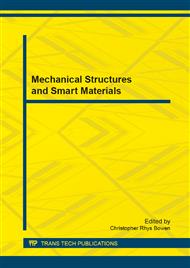p.626
p.630
p.635
p.639
p.643
p.649
p.653
p.659
p.664
A Novel Parallel Decoupled Tri-Axis Force Sensor
Abstract:
This paper presents a novel parallel tri-axis force sensor with decoupled feature, and performs its performance analysis. Firstly, the structural characteristics of the parallel tri-axis force sensor are introduced and the stress distribution of each limb elastomer is analyzed. To measure the transformation relationship between the force and strain, the electric bridge is formed by pasting strain on the elastic-sensitive element. Then, the finite element simulation of the elastomer is conducted and performance analysis of the sensor is carried out, which shows that the parallel tri-axis force sensor is decoupled, linear and fully-isotropy. The sensor possesses good static performance and can meet the requirements of tri-axis force measurement in general industrial production. The contents of this paper riches the structure type of the multi-component force sensor and will be useful for the research and development of the parallel force sensor.
Info:
Periodical:
Pages:
643-648
Citation:
Online since:
January 2014
Authors:
Price:
Сopyright:
© 2014 Trans Tech Publications Ltd. All Rights Reserved
Share:
Citation:


